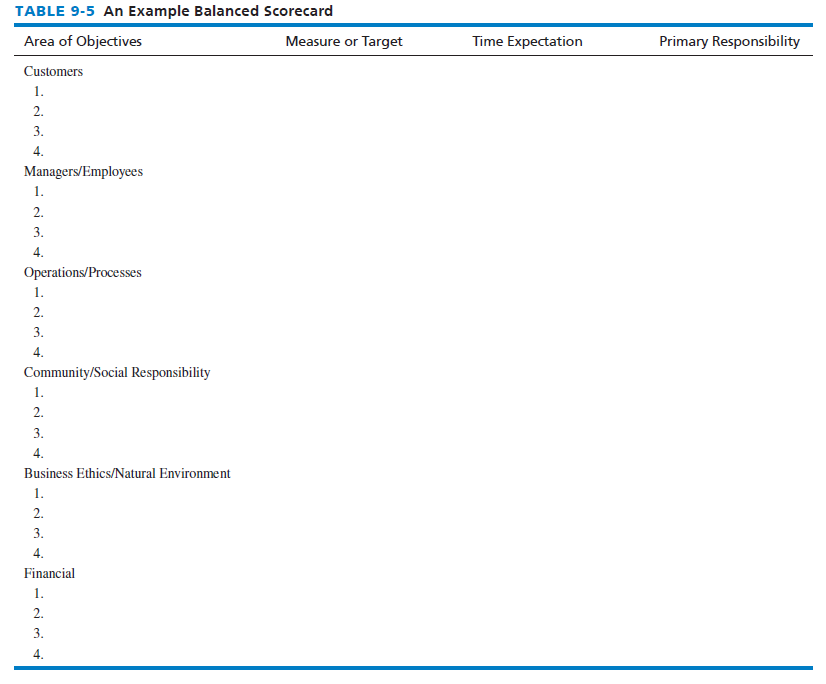Do a Google search using the keywords balanced scorecard images and you will see more than 100 currently used balanced scorecards. Note the wide variation in format evidenced through the images. Developed in the early 1990s by Harvard Business School professors Robert Kaplan and David Norton, and refined continually through today, the Balanced Scorecard is a strategy evaluation and control technique. Balanced Scorecard derives its name from the perceived need of firms to “balance” financial measures that are oftentimes used exclusively in strategy evaluation and control with nonfinancial measures such as product quality and customer service. An effective Balanced Scorecard contains a carefully chosen combination of strategic and financial objectives tailored to the company’s business.
As a tool to manage and evaluate strategy, the Balanced Scorecard is currently in use at Sears, United Parcel Service, 3M Corporation, Heinz, and hundreds of other firms. For example, 3M Corporation has a financial objective to achieve annual growth in earnings per share of 10 percent or better, as well as a strategic objective to have at least 30 percent of sales come from products introduced in the past four years. The overall aim of the Balanced Scorecard is to “balance” shareholder objectives with customer and operational objectives. obviously, these sets of objectives interrelate and many even conflict. For example, customers want low price and high service, which may conflict with shareholders’ desire for a high return on their investment. The Balanced Scorecard concept is consistent with the notions of continuous improvement in management (CIM) and total quality management (TQM).
The Balanced Scorecard basic premise is that firms should establish objectives and evaluate strategies on criteria other than financial measures. Financial measures and ratios are vitally important in strategic planning, but of equal importance are factors such as customer service, employee morale, product quality, pollution abatement, business ethics, social responsibility, community involvement, and other such items. In conjunction with financial measures, these “softer” factors comprise an integral part of both the objective-setting process and the strategy-evaluation process. A Balanced Scorecard for a firm is simply a listing of all key objectives to work toward, along with an associated time dimension of when each objective is to be accomplished, as well as a primary responsibility or contact person, department, or division for each objective.
The Balanced Scorecard is an important strategy-evaluation tool that allows firms to evaluate strategies from four perspectives: financial performance, customer knowledge, internal business processes, and learning and growth. Its analysis requires that firms seek answers to the following questions and use that information, in conjunction with financial measures, to adequately and more effectively evaluate strategies being implemented:
- Is the firm continually improving and creating value along measures such as innovation, technological leadership, product quality, operational process efficiencies, and so on?
- Is the firm sustaining and even improving on its core competencies and competitive advantages?
- How satisfied are the firm’s customers?
A sample Balanced Scorecard is provided in Table 9-5. Notice that the firm examines six key issues in evaluating its strategies: (1) Customers, (2) Managers/Employees, (3) Operations/ Processes, (4) Community/Social Responsibility, (5) Business Ethics/Natural Environment, and (6) Financial. The basic form of a Balanced Scorecard may differ for different organizations. The Balanced Scorecard approach to strategy evaluation aims to balance long-term with short-term concerns, to balance financial with nonfinancial concerns, and to balance internal with external concerns. The Balanced Scorecard would be constructed differently—that is, adapted to particular firms in various industries with the underlying theme or thrust being the same, which is to evaluate the firm’s strategies based on both key quantitative and qualitative measures.
The Balanced Scorecard Institute has a Certification Program that includes two levels of certification: Balanced Scorecard Master Professional (BSMP) and Balanced Scorecard Professional (BSP), both of which are offered in association with George Washington University and are achievable through public workshop participation. The website for this program is http:// www.balancedscorecard.org/
The Graphic Communications Group Limited (GCGL), Ghana’s leading print media organization, recently adopted the Balanced Scorecard to monitor quantitative and qualitative targets set by itself and its staff. A recent article reports that the Balanced Scorecard is used by 65 percent of Fortune 500 companies.10 other companies using the Balanced Scorecard in Ghana are the Social Security and national Insurance Thrust (SSMT), the volta river Authority (vRA), electricity Company of Ghana (ECG), and the Ghana revenue authority (GRA). the Managing Director of GCGL, Mr. Kenneth ashigbey, sees the Balanced Scorecard as a roadmap that will help his company connect its strategy to its vision. the vision of the GCGL “to become the dominant multimedia group in West Mrica, telling the african story.” along with adopting the Balanced Scorecard system, GCGL’s mission was rewritten “to empower our audience and customers everywhere with authentic information and excellent products through visionary leadership and strong brands.” ashigbey says with the introduction of the Balanced Scorecard, the ultimate objective of GCGL is “to be a leading and top-of-the-mind multimedia company in english-speaking West Mrica by 2017.” He also says about the BSC: “We will maintain our leadership position in print media and become one of the top three multimedia organizations in terms of circulation, audience reach, advert spend and sales revenue.” ashigbey refers to the Balanced Scorecard as “a tool for employees to understand how their respective day-to-day work contributes to the company’s success.” As part of the Balanced Scorecard, GCGL set for itself eight core values, which include leadership in all that it does, exhibition of high level of professionalism and integrity, commitment to excellence, customer focus, and working as a team. The firm also set four strategic themes: business growth, operational excellence, service excellence, and innovation.

Source: David Fred, David Forest (2016), Strategic Management: A Competitive Advantage Approach, Concepts and Cases, Pearson (16th Edition).

18 May 2021
17 May 2021
18 May 2021
18 May 2021
18 May 2021
17 May 2021